If you’re using an injectable medication, you’re also using needles and syringes (or an auto-injector, which is a needle and syringe in fancy packaging!)
Content Note: syringes and needles! Images of syringes, one image of a complete capped needle/syringe combo, and a close-up image of a syringe with the base of the cap visible.
Needles and syringes come in all sorts of sizes and styles. Here’s some background information:
The Syringe:
Volume: we like a 1mL syringe for most hormone injections
- You may see it listed as a 1cc syringe.
- If microdosing, we may recommend a 0.3mL or 0.5mL syringe.
Type: we like luer lock (threaded) syringes that allow you to switch needles on the syringe without contaminating the needle or your medicine.
All About Volume:
Syringes are sold by volume, or by how much material they contain. When wandering through your local medical supply store you’ll see a range of syringe volumes from 0.3mL to 60mL. We generally recommend using a 1mL syringe.
Syringes should have measurement markers on the outside of the syringe and be labeled with how much total volume the syringe can hold.

Where can you get syringes?
We can prescribe syringes and needles, but often pharmacies don’t have the the matching styles and sizes, or will only dispense one or two. It may be easier to buy your supplies online. We often recommend Westend Medical Supply and Health Warehouse, because they ship to all 50 states without requiring a prescription! You may find less expensive online stores, and a lot of people use Amazon.
How Much And What Is A mL?
mL is short for Milliliter: there are 1,000 milliliters in one liter.
Millimeters are a measure of volume, which is how much space something takes up, not how much it weighs or how dense it is.
Milliliters aren’t very big: there are a little less than five milliliters in a US teaspoon. (4.929, if we’re being picky.)
Here’s one mL of olive oil in a teaspoon next to 1mL of olive oil in a 1mL syringe.
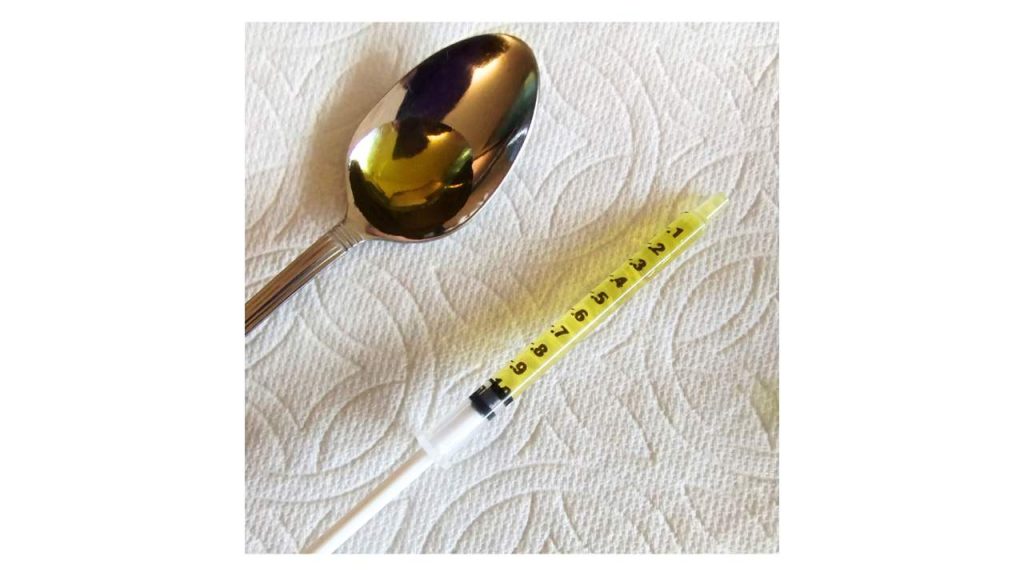
Alternative visualization: one mL of water is about 20 drops of water.
What if it says 1cc?
cc is short for Cubic Centimeter. 1mL of a substance takes up 1 cubic centimeter of space. Milliliters and cubic centimeters are the same amount.
Luer Lock and Luer Slip Syringes
You can buy needles and syringes separately! “Luer” refers to how the syringe and the needle or needles fit together.
A luer lock syringe is threaded at the top: the needle needs to be screwed on. This requires some dexterity to twist the needle on and off of the syringe, but creates a tight connection between the two.
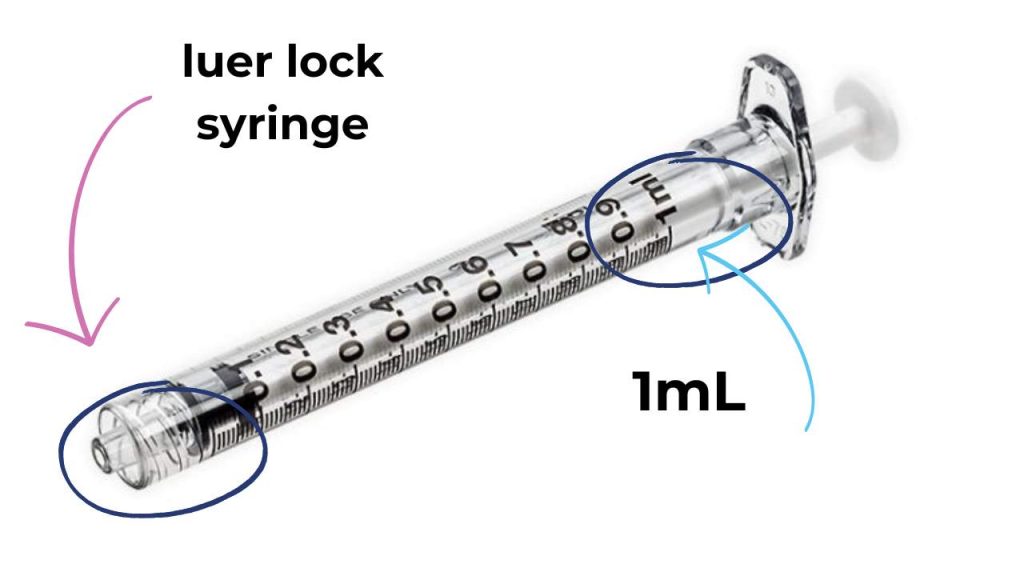
A luer slip syringe slides together to connect. This also takes a little dexterity, but you’re pushing/pulling. It can be a learning curve to learn how to switch between your drawing needle and your injecting needle without pushing on the plunger.
We prefer luer lock syringes!
And we recommend buying your needles and syringes separately.

Why do we want to buy separate needles and syringes?
Because we want to use a different needle for drawing and injecting!
When you use one needle to draw up your medication and a new needle to inject it, you’re on course for
- Less Effort!
- Less Pain!
It’s physics!
Injectable formulations of testosterone and estradiol are suspended in oil, and oil is pretty thick, and can be hard to push through the tiny opening of a needle. Wider-diameter needles are easier to push oil through than smaller-diameter needles, but they hurt more to inject with. Needle tips also dull every time they poke through material, and duller needles hurt more than sharper needles.
Using a larger gauge needle to draw up your meds makes it easier to get the liquid out of the vial. Switching to a smaller gauge needle to inject means less pain and not using the needle more than once. A smaller needle also means less tissue damage and less scarring over time.
Hot Tips for Practice:
If you’re purchasing in bulk, you can get syringes in boxes of 100 syringes and needles in boxes of 50 (example.) That much gear is likely to last you a long time. So why not designate a few as practice materials?
Learn to Twist, Push, and Pull
You can practice attaching and detaching needles to a syringe before you draw up any fluids.
You can practice drawing up fluids, and injecting using cooking oil and an orange. You can even match the oil used in commercial preparations:
Estradiol cypionate and testosterone cypionate are suspended in cottonseed oil.
Estradiol valerate is suspended in caster oil.
Testosterone enanthate is suspended in sesame seed oil.
IMPORTANT SAFETY NOTE: DO NOT use your practice syringes and needles for injections into your body. They will no longer be sterile after practice.
For the most precise dosing, your injection needle should be as short in length and as small in diameter as is comfortable and efficient for your use. This isn’t as important in gender affirming care as in some other types of medicine, but we apply the principle: larger needle for drawing up, smaller needle to inject.
Need a how-to-inject-tutorial? Head over to our Self-Injections page! You may also like to check out our Tips for Less Painful Injections and our Single-Use Vials: Are They Really One-Time Only Use? blogs!
A note on gauges:
The gauge of a needle is the outside diameter of the needle itself. A smaller gauge number means a larger diameter needle. A larger gauge number is a smaller diameter needle.
WAIT THE WHAT NOW?
The gauge system used for hypodermic needles was originally developed for wire. A 1 gauge wire is thicker than a 10 gauge wire, which is thicker than a 20 or 30 gauge wire. (As a kid, Facilitator Unicorn was told that the gauge meant how many of that wire could fit in an inch. It doesn’t quite work that way, but it’s an easier way to wrap your head around gauge sizes, if it doesn’t want to make sense.)
| Gauge | Diameter in Inches | Diameter in Millimeters |
| 1 | 0.300″ | 7.35mm |
| 10 | 0.134″ | 3.404mm |
| 21 | 0.03225″ | 0.819mm |
| 25 | 0.02025″ | 0.515mm |
| 30 | 0.01225″ | 0.312mm |
We like a 21g one to 1.5″ needle to draw, and a 25g 5/8″ needle to inject.
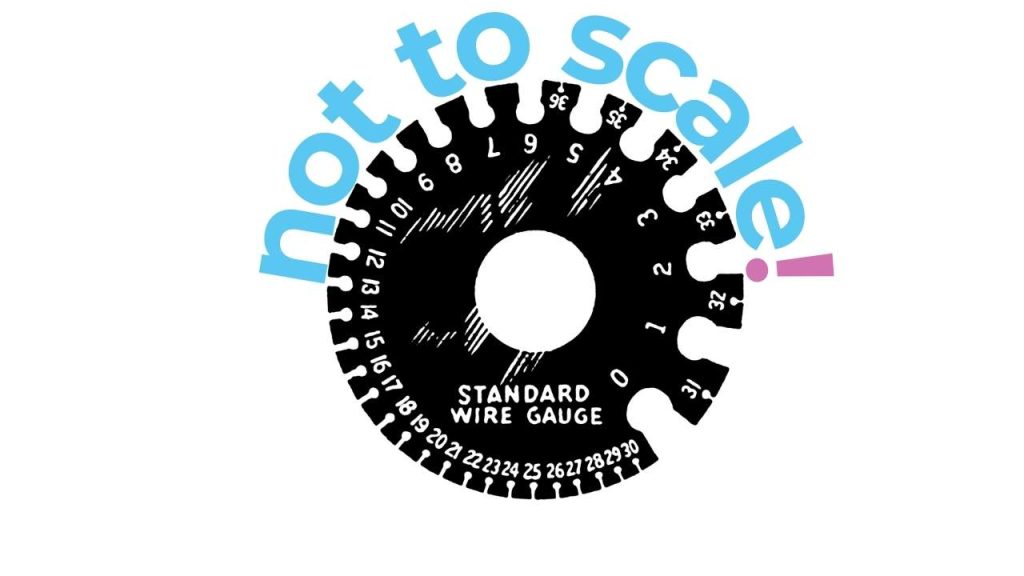
How Much Do I Inject?
Testosterone and estradiol formulations come in milligrams per milliliter: mg per mL. This describes how much medication in milligrams is available in each milliliter of liquid.
Your prescription should tell you:
- how many milligrams of medicine you want to inject each time
- or how much volume of medicine to inject each time
- or both
If you need to figure out how much liquid to inject to get the right dose,
divide the mg you want (Dosage)
by the mg (Strength) in the solution,
and multiply it by the per mL (Concentration) in the vial. The strength and concentration in the below image is 200mg per 1mL.
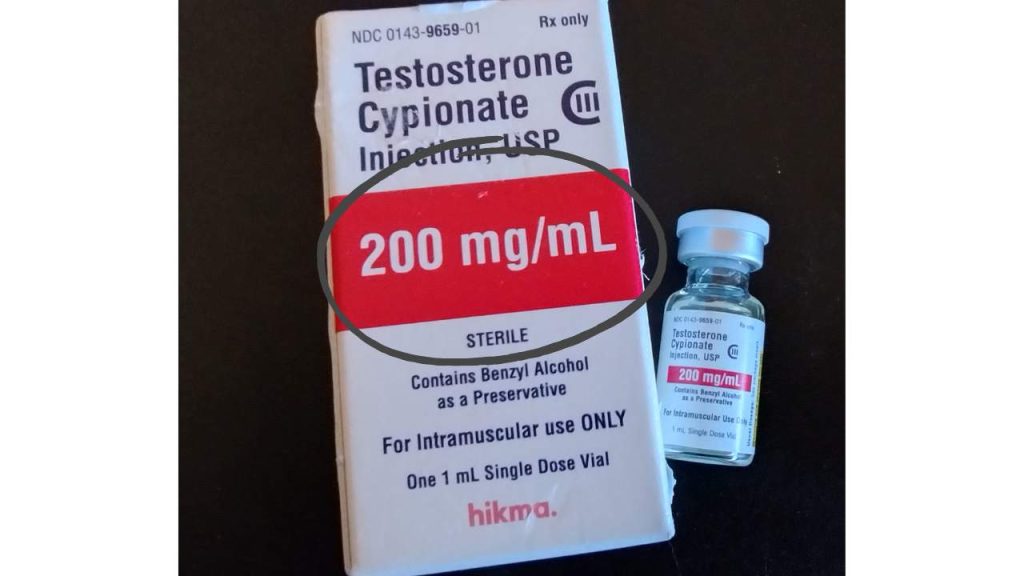
(Dosage divided by Strength) multiplied by Concentration = how much to inject.
Shall we try?
Dosages are totally made up and for illustrative purposes only.
Example:
Desired dosage is 5mg.
Meds are 200mg per 100mL.
(5 mg dosage / 200 mg strength) * 100 mg/mL = injection volume of 2.5mL
(5/100) * 100 = 2.5mL
Example:
Desired dosage is 5mg per injection.
Meds are 100mg per 5mL.
(5mg dosage / 100mg strength) * 5mg per mL = 2.27mL
5/100 * 5 = 2.27mL
Neither of those would fit into a 1mL syringe, but here’s one that would:
Example:
Desired dosage is 5mg per injection.
Meds are 40mg per 1mL.
(5mg dosage / 40mg strength) * 1mg per mL = 0.0125mL
5/40 * 1 = 0.125mL
What Does This Look Like in The Syringe?
The syringe body should have measurements printed on the outside.
If you’re using a 1mL syringe, it likely has:
- small lines for hundredth of a mL (each line is 0.01mL)
- medium lines for twentieth of a mL (each line is 0.05mL)
- long lines for tenth of a mL (each line is 0.1mL)
Match up the plunger to the line to draw your desired dosage. The plunger in between two small lines is roughly 0.005 of a mL)
Note: when drawing, draw more than you want to inject, and push liquid out to your desired dosage.
Here’s a syringe with 0.125mL of olive oil drawn up. Plunger is between the 12th and 13th hundredth-marker lines.
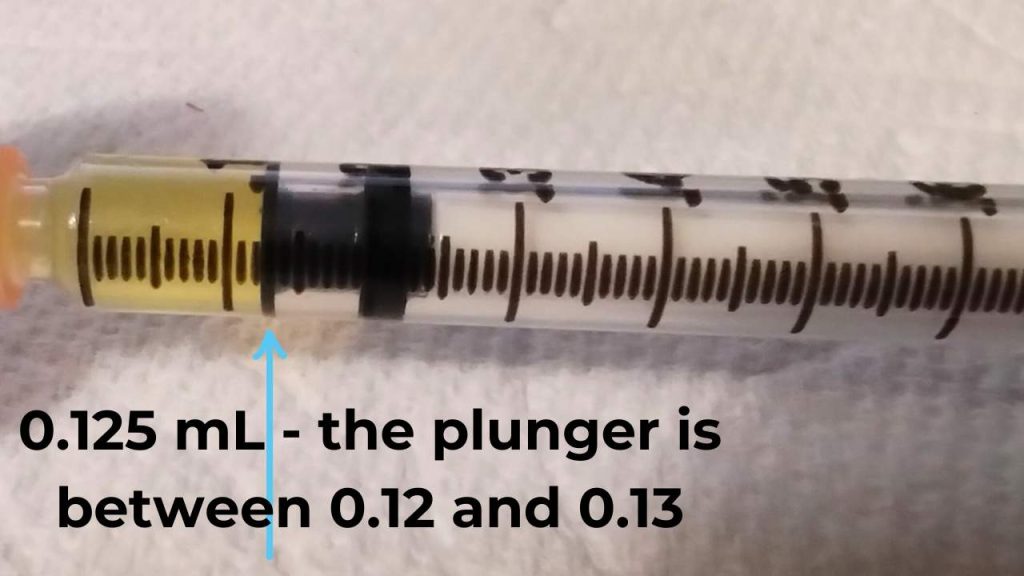
What if your injection volume is really small?
If the volume of your injection is very small, it might be easier to draw up a dose this small using an 0.3mL or 0.5mL syringe.
Syringes with volumes less than 1mL are usually insulin syringes.
Insulin syringes are marked in UNITS, not in mL.
NOTE:
It can be hard to find luer lock syringes when you’re looking for 0.3mL or 0.5mL syringes, so you may only be able to get syringes with needles already attached.
It can also be hard to find luer or attached needles in gauges larger than 28g or longer than 1/2″. It may be more difficult to draw up and inject using these smaller-volume tools, but you may be able to get a more precise dose.
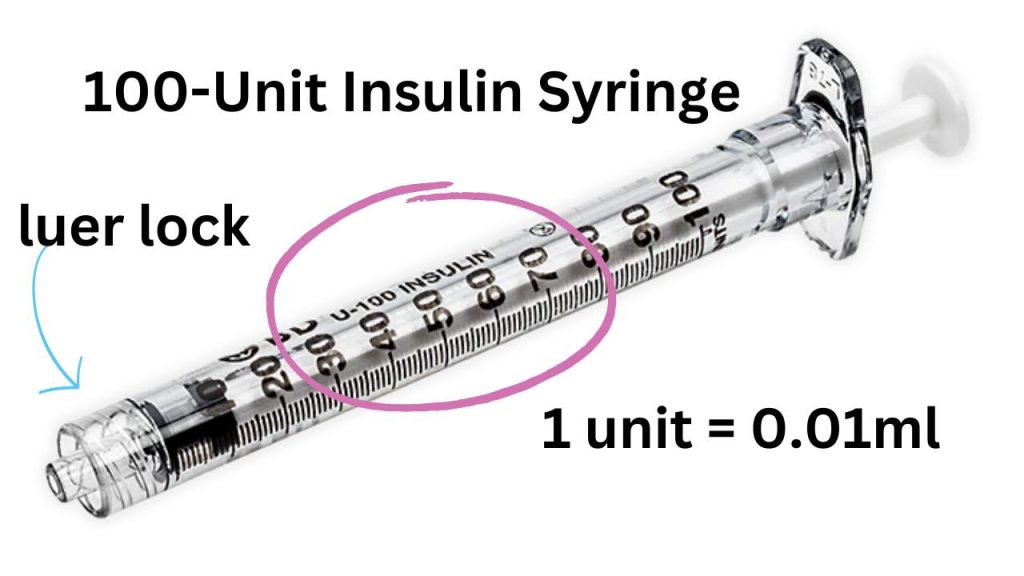
Injectable insuline comes in 100 units per milliliter or 40 units per milliliter, so insulin syringes are marked in units, not milliliters.
To get a correct dosage when using an insulin syringe, you may need to do some math!
A U-100 syringe may hold up to 100 units of insulin. Lucky for us, 1 UNIT of U-100 insulin equals 0.01mL, so we can count each unit on the syringe as 0.01mL.
1 UNIT in a U-100 syringe = 0.01mL.
WATCH FOR: U-100 syringes holding less than 100 units. This is likely to be your 0.3 mL or 0.5 mL syringe.

When using U-40 syringes, you’ll need to do some extra math.
1 UNIT in a U-40 syringe is 0.025mL.
Use your desired volume of injection in milliliters and divide it by 0.025 (U-40) to get your number of UNITS in an insulin syringe.
Example: 5mg per injection. Meds are 40mg/mL.
5/40 * 1 = 0.125mL
divide your desired volume in a 1mL syringe by UNITS volume:
0.125 / 0.01 = 12.5 UNITS in a U-100 syringe
0.125/0.025 = 5 UNITS in a U-40 syringe.
We hope this helps!
